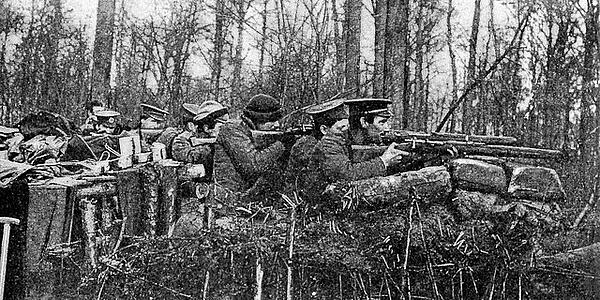Infantry weapons in World War One
Infantry in World War One were armed with standard issue weapons at the beginning of the war. However, by the time the war was over, most infantrymen had learnt how to use other weapons that had been developed during wartime.
British infantry, just like their French and German counterparts, were also issued with their own uniform, as well as webbing and a rifle with bayonet. There were some soldiers who were trained to use the machine gun but many had to rely on their Lee Enfield 0.303 rifle.
The Lee Enfield rifle was first produced in 1907 and was designed by an American called James Lee. The rifles were built at the Royal Small Arms Factory in Enfield and had a good reputation among the officers.
The rifle had a ten-bullet magazine and a high rate of fire when used by soldiers with training. In fact, at the Battle of Mons, the advancing Germans reportedly thought they were being fired on by machine guns as the fire rate was so fast. Fully trained, infantrymen could shoot around 12 accurate bullets every minute.

Despite its reputation, the Lee Enfield did have one weakness: how quickly the firing mechanisms became filled with dirt. This meant that it was vital that infantrymen spent time ensuring their rifle was clean and empty of the mud that was so common in the trenches. Some would even cover their firing mechanism with a cloth when not in battle, to ensure as little mud entered as possible.
While the British men had Lee Enfield’s, the French infantrymen were issued with either Lebel or Berthier rifles. The Lebel was the older of the rifles, having been produced in 1886. This meant the French military had plenty of time to correct the main design fault of the gun: when loading nose to tail there was a chance of the bullets exploding in the magazine. Sadly, this had not been rectified so the loading procedure was slow and the rate of fire was also low once this was completed.
In order to tackle this problem, the French introduced a brand new gun, the Berthier, in 1916. Unlike the Lebel, the Berthier was clip loaded and had a more modern firing mechanism, so there was little chance of explosion during loading. However, there was only space for six rounds so the firing rate was even lower than the Lebel.
German infantrymen were issued with the Mauser rifle, which was designed in 1898 by Peter Paul Mauser. It was very popular among the soldiers. This meant an even slower loading time than the French Berthier, which was a constant issue in battle.
Officers were the only people to be issued a pistol during World War One, with the British Army officers preferring the Webley Mark IV. This pistol was also found on personnel tanks and other armoured vehicles. The Webley was reliable and easy to clean, and a total of 300,000 were distributed among British officers during the war.
In 1908, German Army officers were given the Luger as a pistol. This was another reliable fun and soon became the world’s most used pistol, with around 1.5 million being produced by Germany from 1914 to 1918.
MLA Citation/Reference
"Infantry weapons in World War One". HistoryLearning.com. 2026. Web.
